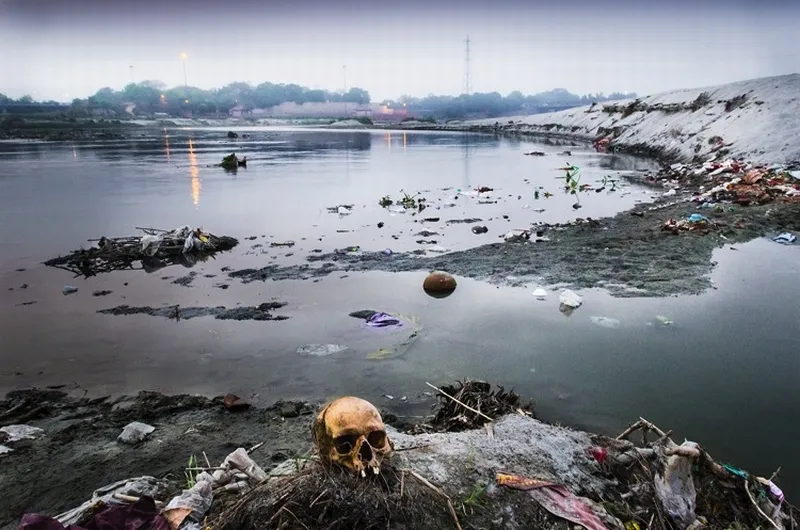A grim scene unfolded once again in Delhi as the Yamuna River, a tributary of the sacred Ganga, became engulfed in toxic foam— a disturbing mix of industrial waste and untreated sewage. The foamy, polluted waters only remind one of the neglect that has plagued this once pristine river.
This is happening in a city already battling hazardous air pollution, with Delhi’s Air Quality Index (AQI) reaching alarming levels. On Friday, the overall AQI stood at 293 in the ‘poor’ category, with certain areas like Anand Vihar and Dwarka recording levels above 300, marking them as ‘very poor.’
But the polluted air isn’t the only sign of a city struggling to breathe; the Yamuna, historically known for its crystal-clear waters, is now a river drowning in waste with Industrial effluents, plastic debris, and rotting organic matter clog the river, presenting a dark reflection of unchecked consumption and negligence.

A Dying River
For those who once depended on the Yamuna for sustenance, the transformation has been devastating. Fishermen like Raman Haldar remember a time when the Yamuna’s waters were so clean, one could drink from it without fear. Sadly, today, the river is an unrecognizable mass of waste and foam. Plastic bags, chemical froth, and food waste have replaced the once clear waters, turning the river into a symbol of environmental collapse.
A recent survey by the Central Pollution Control Board (CPCB) revealed that industries in Panipat, Gurugram, Faridabad, and other industrial hubs around Delhi are the primary culprits. The highest quantity of pollutants comes from Panipat, accounting for 45% of industrial discharges, followed by Gurugram at 25.2%. These discharges contain high levels of ammonia and phosphates, contributing to the formation of toxic foam, which can cause severe respiratory and skin problems.
Where Is The Action?
Despite these alarming figures, little action has been taken against the industries responsible.
The Supreme Court (SC) has shown its willingness to penalize farmers for stubble burning, which contributes to Delhi’s air pollution, but there seems to be an inexplicable reluctance when it comes to holding industries accountable for polluting the Yamuna.
Environmentalists like Vimlendu Jha attribute this to a lack of political will and urgency in cleaning the river. Jha notes that Delhi alone empties more than 3,500 million litres of municipal sewage into the Yamuna, with over half of it either untreated or inadequately treated.
Bhavreen Kandhari, another environmentalist, echoed similar concerns, stating that numerous farmhouses and industries continue to dump pollutants into the river with impunity. Out of 92 drains that open directly into the Yamuna, 62 remain untapped, further exacerbating the problem. The river is choking, but enforcement remains elusive.
Industrial Waste and Eutrophication
Industrial waste is one of the primary sources of river pollution in India, and the Yamuna’s plight is an example to this.
A significant factor aggravating the condition of Indian rivers is eutrophication— the excessive nutrient enrichment of water bodies, often due to improper agricultural practices and untreated sewage discharge. Eutrophication stimulates rampant growth of algae and aquatic plants, suffocating the water.
Worse yet, when these algal blooms eventually die, the process of microbial decomposition consumes dissolved oxygen, creating ‘dead zones’— areas devoid of life. These dead zones render entire stretches of rivers unusable and uninhabitable for most species, making it impossible for ecosystems to sustain themselves.
The Yamuna, From Sacred to Toxic
The Yamuna River, which flows through the heart of Delhi, paints a sad picture of this crisis. Despite accounting for only 2% of the river’s total length, the 22 km stretch through the national capital is responsible for a staggering 76% of the river’s pollution.
Around 90% of untreated household wastewater—laden with laundry detergents and chemicals—flows directly into the river, elevating phosphate levels and leading to the formation of toxic foam. Ironically, this polluted stretch is also the primary source of 70% of Delhi’s water supply, serving around 57 million people.
The pollution, however, is not just from industries and urban waste. Even social and religious practices contribute to the Yamuna’s degradation. Sacred items like flowers, incense, and food offerings—often tied in plastic bags—are dumped into the river after rituals.
Worse, during the devastating second wave of Covid-19 in 2021, thousands of dead bodies were found floating in the Yamuna, as fears of the virus led people to abandon traditional cremations.
Decades of Failed Initiatives
Efforts to clean up the Yamuna have been ongoing for over three decades, but with little success.
The Yamuna Action Plan (YAP), initiated in 1993 as a bilateral project between India and Japan, aimed to restore the river. Two subsequent phases were introduced, and a staggering ₹1,500 crore was spent on the project. Additionally, ₹460 crore was allocated under the ‘Namami Gange Programme,’ an integrated conservation mission by the Indian government. Yet, despite the vast sums of money and resources, the condition of the Yamuna has worsened.
In 2017, the Ganga and Yamuna rivers were even granted the status of living entities by a court in Uttarakhand. This legal designation meant that polluting these rivers would be considered equivalent to harming a human being. Inspired by the recognition of New Zealand’s Whanganui River as a living entity, this ruling was a bold statement of intent. However, the ground reality remains grim, as industries continue to flout regulations, and pollution levels rise unabated.
A Glimpse of Hope During Covid-19 Lockdown
In a strange twist, the Yamuna saw a brief moment of recovery during the 2020 lockdown following the Covid-19 outbreak. With industries shut and human activity at a standstill, the Delhi Pollution Control Committee (DPCC) found that the Yamuna became 33% cleaner. The absence of human intervention allowed the river to heal, albeit temporarily. But as life returned to normal, so did the pollution, and the river quickly reverted to its former, toxic state.

Can the Yamuna Be Saved
The critical question is can we still save the Yamuna, or is it too late?
India’s rivers are vital ecosystems, and their degradation has far-reaching consequences, not only for aquatic life but also for the millions of people who depend on them for drinking water, agriculture, and livelihoods.
It is time to stop turning a blind eye to the industries that are poisoning our rivers. The Yamuna’s death by a thousand cuts is not an isolated incident— it is a microcosm of the larger environmental crisis facing India’s water bodies. If we continue to ignore the warnings, we will be left with rivers that are little more than toxic wastelands.
The plight of the Yamuna is due to the environmental cost of unchecked industrialization and urban growth.
Indian courts, environmentalists, and the public have long called for meaningful action, but efforts to clean the river have repeatedly fallen short. The failure of these initiatives is not merely about governance— it is about the nation’s priorities. Commerce, development, and industrial growth have consistently taken precedence over environmental conservation.
To save the Yamuna and other rivers across India, a comprehensive approach is required. Strict enforcement of environmental laws, investment in sustainable waste management, and public awareness campaigns are essential. Moreover, industries must be held accountable for their role in polluting these vital ecosystems.
The Yamuna cries for help, but who will listen? The answer lies not in more empty promises, but in swift and concrete action— before it’s too late.










